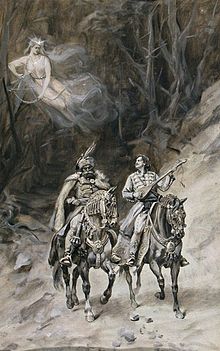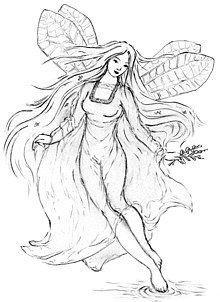This article needs additional citations for
verification. (May 2021) |

A vila, or víla [ˈviːla] (plural: vile, or víly [ˈviːli]; Bulgarian: vila, diva, juda, samovila, samodiva, samojuda; Czech: víla, samodiva, divoženka; Old East Slavic: vila; Polish: wiła; Serbo-Croatian: vila; Slovak: víla; Slovene: vila) [1] is a Slavic fairy similar to a nymph.
The vila is mostly known among South Slavs; however, some variants are present in the mythology of West Slavs as well. Among Czechs, víla denotes a woodland spirit (15th century), and ancient place names such as Vilice near Tábor, Vilov near Domažlice, and Vilín near Sedlčany seem to indicate that she was known there as well. [2] In the Chronicle of Dalimil (3, 53) vila is "fool" (as in Old Polish). In Russia, vile are mentioned in the 11th century, but there is doubt that they were truly a part of Russian folklore, and not just a literary tradition. There are common traits between the vile and the rusalki, and Schneeweis holds that they are identical.
Etymology
The etymology is unclear. Possible explanations are from the verb viti "to wind" and Church Slavonic: vichъrь " whirlwind"; or from Sanskrit: vāyú- "air", ultimately from Proto-Indo-European u̯ēi̯o- "wind".
Folkloric accounts

According to Natalie Kononenko, the vilas are female spirits of nature, of an ambivalent relationship with humans. In fairy tales, they may act with malice towards them (killing people, destroying crops), but may also help the hero by giving him magical objects and mounts. [3] They may also show warrior-like qualities. [4]
There are three kinds, those living on land and in forests ( Serbo-Croatian: zagorkinje, pozemne vile), water nymphs ( Serbo-Croatian: brodarice, povodne vile), and cloud or air nymphs ( Serbo-Croatian: vile oblakinje, zračne vile). They appear as swans, falcons, horses, or wolves; cloud nymphs appear as a whirlwind. At night, they roam the clouds emitting a terrible noise of pipes and drums. Anyone who calls them becomes stiff and moves only with difficulty. He is stricken by disease and dies within a year or two.
Vile like to ride horses or stags, they go hunting, dance in a circle dance ( Serbo-Croatian: vilino kolo, Bulgarian: samodivski igriška) and seek the love of handsome strong men, assisting them against their enemies. Their fondness for fighting is reminiscent of the teutonic Valkyrie and is unique in Slavic mythology. They possess supernatural powers and are able in the art of healing. They build splendid castles at the edges of clouds. They confuse men's spirits with their arrows. They steal children and substitute them with changelings. In Slovakia, vile are the restless souls of deceased girls who lure young men into a deadly circle dance.
In Croatian and Serbian epic poetry, many heroes have a vila as an elective or blood sister ( Serbo-Croatian: posestrima). The best known is Serbo-Croatian: Ravijojla, a name probably derived from Raphael. Girls can also have vile as blood sisters, and may ask them to improve one's beauty or to protect a distant lover.
Vilas are also prominent in Bosniak epic poetry, it is not rare for a vila to guide warriors on their path. Or nourish and help them when they are injured. Folk tales of a vila raising the Hrnjica brothers are well known, where one brother gains his strength from the vila, and the other brother his beauty. Other folk tales mention vilas helping in the defense of towns. [5]
Vile are usually friendly to people, but they can take horrible revenge on those who insult them, disregard their orders, or approach their circle dances uninvited. Their general amiability distinguishes them from the rusalki. The folk venerated them by placing flowers, food and drink before caves where they were believed to have lived.
Within the Czech tradition, víly are almost always malicious, unless respected and avoided. They are portrayed as beautiful women with long flowing hair, who primarily live in the woods, marches, or in forest clearings. They are said to try to entrance men, who wander into their land, by their looks and beautiful voices. Víly are also said to live in groups, and are keen to dancing in circles, which was also another way of trapping people, as it was believed that if you were to start dancing with them, then you would never return home.
According to F. S. Copeland, in Slovene folklore, the vile (which she translated as 'White Ladies') are wise and benevolent beings from forests, water bodies and mountains who help women in childbirth and heroes in epic stories. [6] In another article, according to Copeland, the word was known near the Croatian border (e.g., in Bela Krajna), but also "familiar" among the Slovenes of Styria and Beyond-the-Mura. [7]
Legacy
According to ethnologist Éva Pócs, the word vila also appears in the Serbian and Croatian words vilovnjak, vilenjak, vilenica, vilaš - all referring to a type of "fairy magician", people who, as per historical and folkloric records, were given powers by the vilas ("fairies"). [8]
Western European references
Dictionaries
Meyer's Konversationslexikon defines Wiles or Wilis as female vampires, the spirits of betrothed girls who die before their wedding night. According to Heine, wilis are unable to rest in their graves because they could not satisfy their passion for dancing naked, especially in town squares. They also gather on the highway at midnight to lure young men and dance them to their death. In Serbia, they were maidens cursed by God; in Bulgaria, they were known as samodiva, girls who died before they were baptized; and in Poland, they are beautiful young girls floating in the air atoning for frivolous past lives. In some tales, the reason for abandoning their loves is tragic; the Vila are cursed never to find their true love, and if they do, that love will die a terrible death.
Literature
This legend inspired Victor Hugo to include "les wilis" in his poem "Fantômes" in Les Orientales (1828).
Heinrich Heine in his 1835 De l'Allemagne vividly describes "die Wilis" as a Slavic legend.
In J.K. Rowling's Harry Potter series, veela are magical beings who resemble stunningly beautiful women. They can put men into trance with their singing and dancing, and when angered, they transform into horrific, bird-like creatures and can launch fireballs from their hands. [9] Veela appear in the fourth book of the series, Harry Potter and the Goblet of Fire, where they serve as mascots to the Bulgarian Quidditch team during the Quidditch World Cup. The character Fleur Delacour is also a quarter-veela. [10]
In Heather Walter's Malice duology, the vila serve as a darker counterpart to other fae, based more closely on the Irish interpretations.
Theatre and opera

The wilis appear in Adolphe Adam's Romantic ballet Giselle, first danced in Paris in 1841, as the ghosts of young girls who were betrayed by their lovers and who died before their wedding days. They dance in the forests on moonlit nights, punishing young men by dancing them to death, but must disappear at the break of dawn. These Wilis snatch away the villainous Hilarion's life-breath, and almost do the same for the hero, Albrecht, but he is saved by the love of the ghostly Giselle.
The first opera completed by Giacomo Puccini, Le Villi, makes free use of the same thematic material. It had its debut in May 1884 at the Teatro Dal Verme, Milan, and was revised for a more successful reception at the Royal Theater, Turin, that December.
In "The Vilia Song" ( German: Das Vilja-Lied), from the 1905 operetta The Merry Widow ( German: Die lustige Witwe) by Franz Lehár, Viktor Léon and Leo Stein (and translated by Adrian Ross), a hunter pines for Vilia, "the witch of the wood", a fairy being who causes him to fall in love with her and then vanishes.
References
- ^ Reiter, Norbert (1973). "Mythologie der alten Slaven". In Haussig, Hans Wilhelm (ed.). Wörterbuch der Mythologie (in German). Vol. 2. pp. 163–208.
- ^ Monteiro, Prista (1985). A vila. Sociedade Portuguesa de Autores. OCLC 988222089.
- ^ The Greenwood Encyclopedia of Folktales and Fairy Tales. Edited by Donald Haase. Greenwood Publishing Group, 2008. p. 880.
- ^ Kononenko, Natalie (2007). Slavic Folklore: A Handbook. Greenwood Press. pp. 40, 186. ISBN 978-0-313-33610-2.
- ^ Marjanović, Luka (1898). Hrvatske narodne pjesme, Junačke pjesme Muhamedovske (in Croatian). Zagreb: Matica Hrvatska. p. 36.
- ^ Copeland, F. S. (1949). "Some Aspects of Slovene Folklore". Folklore. 60 (2): 283. doi: 10.1080/0015587X.1949.9717929.
- ^ Copeland, F. S. (1931). "Slovene Folklore". Folklore. 42 (4): 431. doi: 10.1080/0015587X.1931.9718415. JSTOR 1256300.
- ^ Pócs, Éva (December 2009). "Tündéres and the Order of St Ilona or, did the Hungarians have fairy magicians?". Acta Ethnographica Hungarica. 54 (2): 379–396. doi: 10.1556/AEthn.54.2009.2.9.
- ^ Santiago-Irizarry, Vilma (2015). "The Ubiquity of Performance: Theory and Practice in Expressive Genres". Reviews in Anthropology. 44 (2): 75. doi: 10.1080/00938157.2015.1029832.
- ^ Colbert, David (2001). The Magical Worlds of Harry Potter. ISBN 0-9708442-0-4.
Further reading
- Ajdačić, Dejan (5 May 2015). "Вила љубавница у књижевности српског романтизма" [The Lover Fairy in Romantic Serbian Literature]. Studia Mythologica Slavica (in Serbian). 5: 191. doi: 10.3986/sms.v5i0.1802.
- Juric, Dorian (2010). "A Call for Functional Differentiation of the South Slavic Vila". The Journal of Indo-European Studies. 38 (1–2): 172–202. INIST 23214776 ProQuest 1095612316.
- Jurić, Dorian (2023). "Where Does the Vila Live? Returning to a Simple Question". Folklore. 134 (1): 48–72. doi: 10.1080/0015587X.2022.2093966.
- Miller, Dean (2012). "Supernatural Beings and 'Song and Dance': Celtic and Slavic Exemplars". Studia Celto-Slavica. 6: 101–112. doi: 10.54586/VOJO4470.